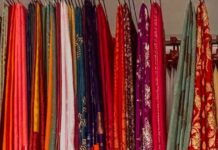By Shaikha Alshamsi
In every city, there is a place that serves as its core and embodies the essence of the city, resonating with its past, reflecting its values and capturing its character. Beneath its narrow alleys and winding streets, stands a district where the old and new converge, where ancient alleyways and historic buildings mingle with modern galleries and creative spaces. Steeped in history and culture, the Heart of Sharjah is a testament to the emirate’s rich heritage.
From the ornate facades of the traditional buildings to the bustling markets and serene courtyards, it is a place that invites visitors to step back in time and relive the memory of United Arab Emirates nationals who have resided on this land for more than a hundred years. It narrates a story that began in a small region in the eastern part of the Arabian Peninsula where Sharjah’s initial foundation started to take shape.
Even though the district was built many centuries ago, it retains the feel of the 1950s. Wandering through its many areas, the Heart of Sharjah beats with great vitality as the vibrant sounds of traditional traders and workers still emanate from every corner of the emirate’s historic neighborhoods.
Located within the old part of Sharjah city in northern UAE, it offers a walk down memory lane through its heritage projects such as Sharjah Fort (Al Hisn) and Bait Al Naboodah Museum. The four souqs including Al Arsah, Al Shanasiyah, Saqr and the old souq offer an immersive and authentic shopping experience where tourists and residents can experience the Emirati taste of spices and the different antiques, handicrafts, traditional clothing and art.
The area where the souks are located also features the remains of settlements that have been excavated, providing every visitor with a glimpse into the fascinating archeological findings of the region.
As one of the emirate’s most prominent heritage buildings, Sharjah Fort is an architectural gem that served as a seat of government, a royal residence, a prison and now a museum. Covering an area of about 5,000 square meters, it has a large and impressive structure. The imposing sand-colored walls, adorned with intricate patterns and Arabic calligraphy showcase an example of a traditional Islamic architecture that is well-preserved.
Heart of Sharjah is considered the region’s largest historical restoration and preservation project, and will be completed by 2025.
The fort was built from coral stones and gypsum, with thick walls and tall towers crafted to shield the city’s residents from attack. These coral stones highlight the historical connection between the fort and the coastal environment of Sharjah as they were collected from the deep-sea waters of the Arabian Gulf.
A light brown plaster covered the walls while the doors displayed the skilled artistry of teak wood. As for the ceilings, they were ingeniously constructed using materials sourced from nature such as mangrove trunks and various parts of palm trees, including fronds, leaves and fibers.
Featuring a spacious yard in the middle, the fort consists of two main floors and three towers built for defensive purposes. As visitors venture through its chambers, they will have the opportunity to immerse themselves in old photographs and archeological artifacts. They can also learn about the historical significance of Al Muhalwasa Jail, which served as the first judicial seat in Sharjah.
The exhibition halls were one of the interesting features of the fort with a collection that chronicled Sharjah’s past. From ancient weapons and traditional attire to archeological discoveries and cultural relics, each piece whispers a tale of a bygone era.
When you walk straight ahead and turn right, you will find a historic home that sits along Sharjah’s coastline. Set around a sun-drenched courtyard, this house originally belonged to the emirate’s renowned pearl merchant, Obaid Al Naboodah. Turned into a museum, the house reflects the UAE’s pearl trade heyday and depicts the Indian, Iranian and European influences in its original architectural design.
Within this charming two-storey house, one is greeted by a grand entrance decorated with elaborate carvings and traditional wind towers. The house is divided into two levels: the lower floor accommodates the bedrooms, while the upper floor houses a delightful summer house for leisure and relaxation.
Throughout the place, screen panels made of gypsum that feature floral patterns welcome the visitors. These panels have both ornamental and practical purposes, allowing the passage of sunlight and enabling the refreshing flow of air. The doors, crafted from teak wood, include Indian-inspired designs that reflect the influence of other cultures. Insets on the walls are characterized by their geometric borders.
The space within the house includes Al Naboodah family’s holdings, which ranges from artifacts to coins that originated in India and the Gulf region.


All these features take visitors on a journey to get an insight into the daily routines of a prominent pearling family who once lived there.
As soon as you exit Bait Al Naboodah, head east towards al Zahra Street and then continue walking straight for ten minutes until you reach Al Hisn road, and you will find the next destination on your right.
A place known for its collection of Arab art, the Sharjah Art Museum provides a platform for Emirati and international artists to showcase their different talents. The museum is a sprawling, modern space surrounded by heritage buildings that seamlessly come together to offer visitors an immersive encounter with the rich history and culture of Sharjah.
Other than organizing temporary exhibitions, the building, which includes two wings interconnected by two passageways that span over an interior street, displays a remarkable permanent collection of Arab modern art. It also features well-known artwork by the late Jordanian and Syrian artists Mona Saudi and Louay Kayali.
The museum takes great pride in its exceptional collection of artworks by orientalist artists. One of them includes a gallery, which exhibits the renowned collection of The Ruler of Sharjah, His Highness Dr. Sheikh Sultan Bin Muhammad Al Qasimi.
Located right across from the museum is a marketplace where much of the emirate’s mercantile history was born. Known as one of the oldest and most vibrant marketplaces in the Gulf region, Souk Alshanasiyah covers around six-thousand square meters. Its expansive length borders the Sharjah Creek on one side, enhancing its scenic appeal.
As you enter the souq, you find several retail outlets, which range from restaurant and boutique cafés to shops selling antiques and gifts, Emirati craftmanship and fashion, perfumes, dates and traditional sweets.
Most of these businesses cater to the needs of contemporary travelers by providing modern amenities and offers, while maintaining an ambiance that harkens back to the nostalgic charm of Sharjah’s past.
The Sharjah Art Museum is one of the venues of the Sharjah Biennial. It also hosts the annual Sharjah Islamic Arts Festival, a cultural event organized by the Sharjah Department of Culture.
Ratios Café provides a distinctive experience where visitors can enjoy specialty coffee and delicious gourmet snacks in a setting decorated with traditional furniture made from old dhows.
A valuable addition to the souq is the Arabian Tea House restaurant, which serves traditional Emirati food and Arabic cuisine. It’s also sprinkled with cultural significance and a historical setting.
In this place, visitors can treat themselves to a delectable selection of Emirati breakfast trays, grills, light lunches and an extensive range of teas from Australia, China, India, Canada and the Czech Republic. It’s a destination where one can immerse oneself into the Emirati culture, surrounded by photographs that transport you back to the old days of the UAE.
Next to it is Souk Al Arsah, which was a meeting place for camels and Bedouins. Here, visitors can stroll through the comfortably air-conditioned passageways of the market that are designed with sturdy wooden doors, coral brick walls and hanging lanterns.
Within the souk, one can discover shops that sell a wide variety of traditional handicrafts, both new and antique such as bridal pearl chests, copper coffee pots and exquisite carpets.
The heart of Sharjah is a neighborhood that truly has something for everyone. The old neighborhood continues to gain recognition; it is an important tourist destination and a must visit.


















